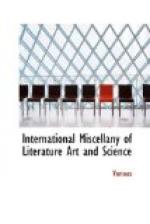Title: International Miscellany of Literature, Art and Science, Vol. 1, No. 3, Oct. 1, 1850
Author: Various
Release Date: December 23, 2004 [eBook #14431]
Language: English
Character set encoding: ISO-646-us (us-ASCII)
***Start of the project gutenberg EBOOK international miscellany of literature, art and science, vol. 1, No. 3, Oct. 1, 1850***
E-text prepared by Joshua Hutchinson, G. Graustein, and the Project Gutenberg Online Distributed Proofreading Team from images generously made available by Cornell University
Note: The scans which were used to create this
issue were incomplete.
Where we were
unable to fully read a word it has been marked
with a note to
that effect.
Images of the
original pages are available in the Making of
America Collection
of Cornell University Library. See
http://cdl.library.corne
ll.edu/moa/browse.journals/intr.html
THE INTERNATIONAL MISCELLANY
Of Literature, Art, and Science.
Vol. 1. New York, October 1, 1850. No. 3.
[Illustration:
Henry brougham, lord brougham
and Vaux.
From A sketch by Alfred CROWQUILL,
made in July, 1850.]
LORD BROUGHAM.
It is generally understood that this most illustrious Englishman now living, will, in the course of the present year, visit the United States. Whatever may be the verdict of the future upon his qualities or his conduct as a statesman, it is scarcely to be doubted that for the variety and splendor of his abilities, the extent, diversity and usefulness of his labors, and that restless, impatient and feverish activity which has kept him so long and so eminently conspicuous in affairs, he will be regarded by the next ages as one of the most remarkable personages in the age now closing—the second golden age of England. Lord Brougham is of a Cumberland family, but was born in Edinburgh (where his father had married a niece of the historian Robertson), on the 19th of September, 1779. He was educated at the University of his native city, and we first hear of him as a member of a celebrated debating society, where he trained himself to the use of logic. He was not yet sixteen years of age when he communicated a paper on Light to the Royal Society of London, which was printed in their transactions; and before he was twenty he had written discussions of the higher geometry, which, appearing in the same repository of the best learning, attracted the general attention of European scholars. In 1802, with his friends Jeffrey, Francis Homer, and




